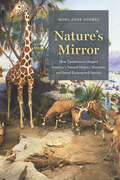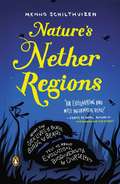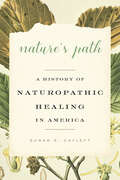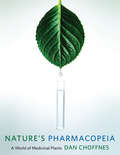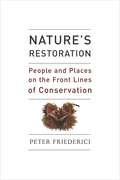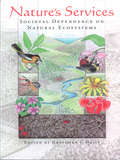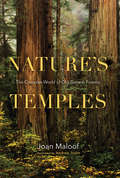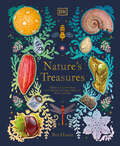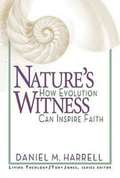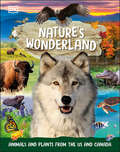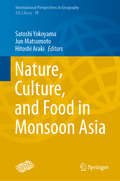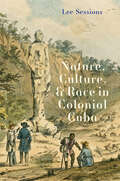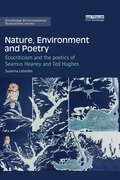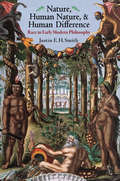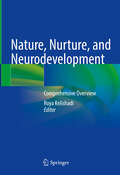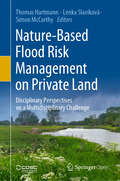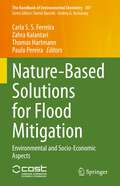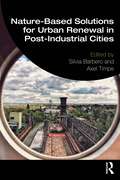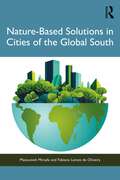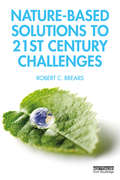- Table View
- List View
Nature's Mirror: How Taxidermists Shaped America’s Natural History Museums and Saved Endangered Species
by Mary Anne AndreiIt may be surprising to us now, but the taxidermists who filled the museums, zoos, and aquaria of the twentieth century were also among the first to become aware of the devastating effects of careless human interaction with the natural world. <p><p> Witnessing firsthand the decimation caused by hide hunters, commercial feather collectors, whalers, big game hunters, and poachers, these museum taxidermists recognized the existential threat to critically endangered species and the urgent need to protect them. The compelling exhibits they created—as well as the scientific field work, popular writing, and lobbying they undertook—established a vital leadership role in the early conservation movement for American museums that persists to this day. <p><p> Through their individual research expeditions and collective efforts to arouse demand for environmental protections, this remarkable cohort—including William T. Hornaday, Carl E. Akeley, and several lesser-known colleagues—created our popular understanding of the animal world and its fragile habitats. For generations of museum visitors, they turned the glass of an exhibition case into a window on nature—and a mirror in which to reflect on our responsibility for its conservation.
Nature's Nether Regions
by Menno SchilthuizenThe story of evolution as you've never heard it before What's the easiest way to tell species apart? Check their genitals. Researching private parts was long considered taboo, but scientists are now beginning to understand that the wild diversity of sex organs across species can tell us a lot about evolution. Menno Schilthuizen invites readers to join him as he uncovers the ways the shapes and functions of genitalia have been molded by complex Darwinian struggles: penises that have lost their spines but evolved appendages to displace sperm; female orgasms that select or reject semen from males, in turn subtly modifying the females' genital shape. We learn why spiders masturbate into miniature webs, discover she dungflies that store sperm from attractive males in their bellies, and see how, when it comes to outlandish appendages and bizarre behaviors, humans are downright boring. Nature's Nether Regions joyfully demonstrates that the more we learn about the multiform private parts of animals, the more we understand our own unique place in the great diversity of life.
Nature's Nether Regions
by Menno SchilthuizenA tour of evolution's most inventive--and essential--creations: animal genitaliaForget opposable thumbs and canine teeth: the largest anatomical differences between humans and chimps are found below the belt. In Nature's Nether Regions, ecologist and evolutionary biologist Menno Schilthuizen invites readers to discover the wondrous diversity of animalian reproductive organs. Schilthuizen packs this delightful read with astonishing scientific insights while maintaining an absorbing narrative style reminiscent of Mary Roach and Jerry Coyne. With illustrations throughout and vivid field anecdotes--among them laser surgery on a fruit fly's privates and a snail orgy--Nature's Nether Regions is a celebration of life in all shapes and sizes. understand our own unique place in the great diversity of life.
Nature's Path: A History of Naturopathic Healing in America
by Susan E. CayleffAn eclectic group of firebrands overcame strong odds to create the naturopathic healing system.An alternative medical system emphasizing prevention through healthy living, positive mind-body-spirit strength, and therapeutics to enhance the body’s innate healing processes, naturopathy has gained legitimacy in recent years. In Nature’s Path—the first comprehensive book to examine the complex history and culture of American naturopathy—Susan E. Cayleff tells the fascinating story of the movement’s nineteenth-century roots.While early naturopaths were sometimes divided by infighting, they all believed in the healing properties of water, nutrition, exercise, the sun, and clean, fresh air. Their political activism was vital to their professional formation: they loathed the invasive, depletive practices of traditional medicine and protested against medical procedures that addressed symptoms rather than disease causes while resisting processed foods, pharmaceuticals, environmental toxins, and atomic energy. Cayleff describes the development of naturopathy’s philosophies and therapeutics and details the efforts of its proponents to institutionalize the field. She recognizes notable naturopathic leaders, explores why women doctors, organizers, teachers, and authors played such a strong role in the movement, and identifies countercultural views—such as antivivisection, antivaccination, and vegetarianism—held by idealistic naturopaths from 1896 to the present.Nature’s Path tracks a radical cultural critique, medical system, and way of life that links body, soul, mind, and daily purpose. It is a must-read for historians of medicine and scholars in women’s studies and political history, as well as for naturopaths and all readers interested in alternative medicine.
Nature's Pharmacopeia: A World of Medicinal Plants
by Dan ChoffnesThis beautifully illustrated, elegantly written textbook pairs the best research on the biochemical properties and physiological effects of medicinal plants with a fascinating history of their use throughout human civilization, revealing the influence of nature's pharmacopeia on art, war, conquest, and law. By chronicling the ways in which humans have cultivated plant species, extracted their active chemical ingredients, and investigated their effects on the body over time, Nature's Pharmacopeia also builds an unparalleled portrait of these special herbs as they transitioned from wild flora and botanical curiosities to commodities and potent drugs. The book opens with an overview of the use of medicinal plants in the traditional practices and indigenous belief systems of people in the Americas, Africa, Asia, and ancient Europe. It then connects medicinal plants to the growth of scientific medicine in the West. Subsequent chapters cover the regulation of drugs; the use of powerful plant chemicals—such as cocaine, nicotine, and caffeine—in various medical settings; and the application of biomedicine's intellectual frameworks to the manufacture of novel drugs from ancient treatments. Geared toward nonspecialists, this text fosters a deep appreciation of the complex chemistry and cultural resonance of herbal medicine, while suggesting how we may further tap the vast repositories of the world's herbal knowledge to create new pharmaceuticals.
Nature's Restoration: People and Places on the Front Lines of Conservation
by Peter FriedericiAcross America and around the world, people areworking to help nature heal itself. In Bermuda, a mansingle-handedly grows thousands of trees on a smallisland to restore nesting habitat for a rare seabird. InIllinois, legions of volunteers replant prairies in theshadows of freeways. In Virginia, a farmer works tobring back the mighty American chestnut.What drives these individuals? How did their passionscome about, and what are the implications forrestoring the environment? Nature"s Restoration: People and Places on theFront Lines of Conservation is a lyrical look at these and other examplesof ordinary citizens aiming to return sizable tracts of the Americanlandscape to nature, and to health. They"ve found success in preservingrare species, reversing negative ecological trends, and promotinggreater intimacy with nature.Yet the work is far from simple. Restoration projects are often in thenews not only because of the promise they hold, but also because ofthe controversy they provoke. Based on detailed reporting and numerousinterviews, Nature"s Restoration puts us on the front lines ofrestoration to learn how this burgeoning national movement shapesboth places and people.
Nature's Services: Societal Dependence On Natural Ecosystems
by Stephen Carpenter Gretchen Daily Les Kaufman Kamaljit Bawa Charles H. Peterson Sandra PostelLife itself as well as the entire human economy depends on goods and services provided by earth's natural systems. The processes of cleansing, recycling, and renewal, along with goods such as seafood, forage, and timber, are worth many trillions of dollars annually, and nothing could live without them. Yet growing human impacts on the environment are profoundly disrupting the functioning of natural systems and imperiling the delivery of these services.Nature's Services brings together world-renowned scientists from a variety of disciplines to examine the character and value of ecosystem services, the damage that has been done to them, and the consequent implications for human society. Contributors including Paul R. Ehrlich, Donald Kennedy, Pamela A. Matson, Robert Costanza, Gary Paul Nabhan, Jane Lubchenco, Sandra Postel, and Norman Myers present a detailed synthesis of our current understanding of a suite of ecosystem services and a preliminary assessment of their economic value. Chapters consider: major services including climate regulation, soil fertility, pollination, and pest control philosophical and economic issues of valuation case studies of specific ecosystems and services implication of recent findings and steps that must be taken to address the most pressing concerns Nature's Services represents one of the first efforts by scientists to provide an overview of the many benefits and services that nature offers to people and the extent to which we are all vitally dependent on those services. The book enhances our understanding of the value of the natural systems that surround us and can play an essential role in encouraging greater efforts to protect the earth's basic life-support systems before it is too late.
Nature's Temples: The Complex World of Old-Growth Forests
by Joan Maloof“Maloof eloquently urges us to cherish the wildness of what little old-growth woodlands we have left. . . . Not only are they home to the richest diversity of creatures, but they work hard for humans too.” —New York Times Book Review An old-growth forest is one that has formed naturally over a long period of time with little or no disturbance from humankind. They are increasingly rare and largely misunderstood. In Nature’s Temples, Joan Maloof, the director of the Old-Growth Forest Network, makes a heartfelt and passionate case for their importance. This evocative and accessible narrative defines old-growth and provides a brief history of forests. It offers a rare view into how the life-forms in an ancient, undisturbed forest—including not only its majestic trees but also its insects, plant life, fungi, and mammals—differ from the life-forms in a forest manipulated by humans. What emerges is a portrait of a beautiful, intricate, and fragile ecosystem that now exists only in scattered fragments. Black-and-white illustrations by Andrew Joslin help clarify scientific concepts and capture the beauty of ancient trees.
Nature's Treasures: Tales Of More Than 100 Extraordinary Objects From Nature (DK Treasures)
by Ben HoareReveal extraordinary stories form nature by best-selling author Ben Hoare with this awe-inspiring animal book for curious kids aged 6-8.The world is filled with curious objects made by plants,animals, and even by the Earth itself. The wonder of wildlife is so much bigger than young minds can fathom and there is always more to learn. Nature&’s Treasures is a stunning nature encyclopedia for young readers to explore, with reference pages packed with fascinating information, little learners will be captivated as they dive into this collection of more than 100 intriguing items from the natural world and discover the stories behind them. Whether it&’s learning how bristly mouths help huge whales capture tiny animals, how minute scales make butterflies shine in the sunlight, or how studying a leaf skeleton can tell us how it transports food, children can learn all sorts of fun animal facts from the storybook descriptions.Arranged into four chapters: Animals; Plants, fungi, and algae; Minerals and rocks, and Made by nature, objects are shown with truly stunning photography and colourful illustrations to help kids understand the science behind them. The lively descriptions by best-selling nature writer Ben Hoare explore the remarkable tales of each item and all are packed with fascinating information. Nature&’s Treasures takes you on a tour of our planet through commonplace-but-incredible objects made by nature itself. The engaging storybook-style descriptions and simple text shed a light on the wonders of nature and wildlife, making this book ideal for inquisitive children aged 6-8 who loves to spot things when exploring outside and wants to know more about the wonderful and mysterious natural world.Celebrate your child&’s curiosity as they:- Explore unique and intriguing approach to exploring nature- Reveal remarkable features of plants and animals, the nests and structures they make- Uncover more than 100 amazing individual objects found in the natural worldThis nature encyclopedia for children is the perfect blend of storybook style text with out of this world illustrations which makes it a fantastic nature book for children who are obsessed with wildlife and the natural world. Encourage young readers to go on a journey to explore a world of information, making this the ideal first reference book for kids aged 6-8 to enjoy for hours on end, whether reading with the family or reading alone, this fun fact book also doubles up as the perfect gift for curious kids who love to learn. Explore the vastness of space by uncovering: -Stunning Jacket Detail: gold foil, holographic foil & metallic gold edges-Striking photography & illustrations inside-A beautiful book for the whole family to treasure -A quality gift to be passed down through the generationsMore in the SeriesNature&’s Treasures is part of the beautiful and informative Anthology series. Complete the series and nurture your child's curiosity as they explore the natural world with The Wonders of Nature or let them walk with the dinosaurs who ruled the earth before them in Dinosaurs and other Prehistoric Life.
Nature's Wealth
by Pieter J. H. van Beukering Elissaios Papyrakis Jetske Bouma Roy Brouwer Pieter J. H. van Beukering Elissaios Papyrakis Jetske BoumaIncreasing pressure from economic development and population growth has resulted in the degradation of ecosystems around the world and the loss of the essential services that they provide. Understanding the linkages between ecosystem service provisioning and human well-being is crucial for the establishment of effective environmental and economic development policy. Presenting new insights into the relationship between ecosystem services and livelihoods in developing countries, this book takes up the challenge of assessing these links to demonstrate their importance in policy development. It pays special attention to innovative management opportunities that improve local livelihoods and alleviate poverty while enhancing ecosystem protection. Based on eighteen studies in more than twenty developing countries, the authors explore the role of biodiversity-, marine-, forest-, water- and land-related ecosystem services, making this an invaluable contribution to research on the role of ecosystems in supporting the livelihoods of the poor around the world.
Nature's Witness: How Evolution Can Inspire Faith (Living Theology)
by Daniel M. HarrellPeople of faith insist that God is the God of the world around us. Yet scientific evidence supporting evolution seems to offer an explanation of reality different from the biblical one. In light of this apparent conflict, some choose either to deny the scientific data or separate science and faith from each other, giving the appearance that faith is disconnected from reality. Others accommodate faith to science, but run the risk of watering down faith such that faith "fills in the blanks" left by science. Against these options, Daniel Harrell asserts that the evidence for evolution accurately describes the world we see, but insists that this description does not adequately serve as an explanation for the world. Rather than seeing science and faith as diametrically opposed, Harrell suggests that evolutionary data actually opens the door for deeper theological reflection on God’s creation. Writing out of a pastoral concern for those struggling to negotiate faith and evolution, Harrell argues that being reliable witnesses to creation helps people of faith be reliable witnesses to its creator. Whether they are pastors wondering how to talk about these issues with their congregations, or students asking whether their biology classes make their faith irrelevant, Harrell’s readers are winsomely led on a journey of exploration in which a robust biblical faith can be held along with affirmation of the scientific data for evolution.
Nature's Wonderland: Animals and Plants from the US and Canada
by DKGo on a thrilling adventure and discover the amazing natural landmarks and diverse wildlife of Canada and the USA. There&’s nowhere on Earth like North America… From scorching deserts to frozen tundra, dense rainforests to coral reefs—this continent has it all! In this captivating nature book, children can take a tour of the most amazing environments across Canada and the US, the two biggest countries in North America.Children aged 7-9 can learn all about incredible natural features like Niagara Falls — and find out which North American waterfall is actually higher! Get to know the unique animals that live only in southern Florida. Find out which species can survive in Death Valley, the hottest place in the world. Full of amazing photographs and charming illustrations, this fascinating nature book is your ultimate guide to the amazing natural wonders, wildlife, and environments of Canada and the USA.This educational book for wildlife lovers features:- More than 200 entries on incredible natural landmarks, plants, and animals from across the USA and Canada- Beautiful illustrations, stunning photography, and engaging text are combined to make dynamic, scrapbook-style collage pages- Chapters each split into broad regions such as western USA, with pages that focus on significant sub-regions within the area, such as the Pacific Northwest and the Rocky Mountain- 30 feature pages that go into detail on key natural features across the regionNature&’s Wonderland is the perfect book for children who are fascinated by nature and curious about North America&’s habitats! With engaging information and absorbing photography, this book is perfect for children to explore by themselves or with an equally curious adult.
Nature, Culture, and Food in Monsoon Asia (International Perspectives in Geography #10)
by Satoshi Yokoyama Jun Matsumoto Hitoshi ArakiThe giant Asian monsoon has formed a diverse climate and natural environment. The Asian monsoon climate manifests itself in manifold ways depending not just on the latitude or altitude of an area but also on physical conditions such as topography and vegetation and even the size of its human population. Likewise, the livelihoods of people in the affected area are diverse. This book focuses on nature and agriculture, food, and climate and culture as an excellent framework for understanding the relationship between humans and the environment in complex Monsoon Asia. Through the discussions in this book, what the authors have sought to demonstrate is that the livelihoods in Monsoon Asia demonstrate unique forms in a limited environment, while the Asian monsoon climate has one of the largest movements of any natural phenomenon on a macroscopic scale. These manifest forms are diverse both on a time scale and on a spatial scale and are extremely diversified in limited regions. Such diversity is not only due just to the effects of the natural environment but also results from social and cultural forces. In this area of Monsoon Asia, traditional and religious social norms are becoming entangled with “new” economic and political norms brought in from the outside world by globalization.
Nature, Culture, and Race in Colonial Cuba (Yale Agrarian Studies Series)
by Lee SessionsA new and necessary examination of how nineteenth-century Cuban white elites viewed the natural world, material culture, and political power as intertwined In the decades before the Cuban wars of independence, white elites exploited the island&’s natural history and culture to redefine racial identity and reassert authority. These practices occurred in the face of challenges to their political power from Cubans of mixed race and as Cuba&’s dependence on sugar led to ecological and economic precarity. Lee Sessions uses close visual analysis to investigate how white elites wielded power by manipulating material culture, placing in conversation for the first time the natural history museums, botanical gardens, and thousands of paintings, drawings, and prints produced in and about Cuba from 1820 to 1860. This important and novel book explores how groups used material culture to imagine their own future at a moment when racial and political dynamics were changing rapidly, while facing an ecological disaster of unimaginable scale.
Nature, Culture, and Society
by Gisli PalssonLife is currently one of the most active zones of politics and economic production, as biological material is increasingly the subject of engineering, banking, reproduction, and exchange. These developments represent some of the most challenging issues facing humanity in the twenty-first century and call for new forms of engagement - and new anthropologies of life. Reflecting upon the changing human condition, Palsson addresses various conflated zones of life at particular times and scales, from the genome to the human body and the global environment. Using a 'biosocial' perspective, he argues, will help us to capture the hybrid nature of life, enhancing our sensitivity to differences and similarities in hierarchies, the reproduction of bio-objects and the exchange between humans, other species, and the environment. Engaging with topical issues on the public agenda, from personal genomics to human-animal relations to the global environment, the book sets out a compelling case for meaningful change.
Nature, Environment and Poetry: Ecocriticism and the poetics of Seamus Heaney and Ted Hughes (Routledge Environmental Humanities)
by Susanna LidströmThe environmental challenges facing humanity in the twenty-first century are not only acute and grave, they are also unprecedented in kind, complexity and scope. Nonetheless, or therefore, the political response to problems such as climate change, biodiversity loss and widespread pollution continues to fall short. To address these challenges it seems clear that we need new ways of thinking about the relationship between humans and nature, local and global, and past, present and future. One place to look for such new ideas is in poetry, designed to contain multiple levels of meaning at once, challenge the imagination, and evoke responses that are based on something more than scientific consensus and rationale. <P><P> This ecocritical book traces the environmental sensibilities of two Anglophone poets; Nobel Prize-winner Seamus Heaney (1939-2013), and British Poet Laureate Ted Hughes (1930-1998). Drawing on recent and multifarious developments in ecocritical theory, it examines how Hughes's and Heaney's respective poetics interact with late twentieth century developments in environmental thought, focusing in particular on ideas about ecology and environment in relation to religion, time, technology, colonialism, semiotics, and globalisation. <P><P> This book is aimed at students of literature and environment, the relationship between poetry and environmental humanities, and the poetry of Ted Hughes or Seamus Heaney
Nature, Human Nature, and Human Difference
by Justin E. H. SmithPeople have always been xenophobic, but an explicit philosophical and scientific view of human racial difference only began to emerge during the modern period. Why and how did this happen? Surveying a range of philosophical and natural-scientific texts, dating from the Spanish Renaissance to the German Enlightenment, Nature, Human Nature, and Human Difference charts the evolution of the modern concept of race and shows that natural philosophy, particularly efforts to taxonomize and to order nature, played a crucial role.Smith demonstrates how the denial of moral equality between Europeans and non-Europeans resulted from converging philosophical and scientific developments, including a declining belief in human nature's universality and the rise of biological classification. The racial typing of human beings grew from the need to understand humanity within an all-encompassing system of nature, alongside plants, minerals, primates, and other animals. While racial difference as seen through science did not arise in order to justify the enslavement of people, it became a rationalization and buttress for the practices of trans-Atlantic slavery. From the work of François Bernier to G. W. Leibniz, Immanuel Kant, and others, Smith delves into philosophy's part in the legacy and damages of modern racism. With a broad narrative stretching over two centuries, Nature, Human Nature, and Human Difference takes a critical historical look at how the racial categories that we divide ourselves into came into being.
Nature, Nurture, and Neurodevelopment: Comprehensive Overview
by Roya KelishadiFrom the birth, children grow and learn in response to the stimulation from their social and physical environment. Research on early brain development provides a great opportunity to examine how nature and nurture work together to shape human development. Through the use of sophisticated technology, scientists have discovered how early brain development and nurturing care interact to create a foundation for future growth and learning. New evidence supports the effect of nature-nurture interactions on childhood development primarily through advances in longitudinal studies. Neural processes, influenced by genetic and epigenetic variation, and other underlying factors including environment, infection, inflammation, hormonal and immune functions, etc., have critical roles in brain development. The term "nurturing care" was described as a core component for achieving optimal development in the early years of life, when the brain is developing and the child is more responsive to interventions. Recent evidence has revealed that parenting interventions that include components to enhance child learning or strengthen parent-child relationships are effective for improving early cognitive, language, motor, and socioemotional development. This book aims: (1) to describe various domains of neurodevelopment in children; (2) to report the estimates of children at risk of not achieving their developmental potential; (3) to present a life course conceptual framework of early childhood development; (4) to review new aspects of neurodevelopment in children; eg., neurobiology, neuroimmunology; (5) to describe the risk factors affecting early brain development; (6) to report the neurodevelopment screening tools in children; (7) to assess the role of nurturing care in early brain development; and (8) to describe programs and policies implemented for early childhood development and their effectiveness for improving development in childhood.
Nature-Based Cities: Performance-Driven Design Approaches for Climate Change Adaptation (Digital Innovations in Architecture, Engineering and Construction)
by Katia Perini Francesca MoscaThis book introduces a groundbreaking approach to urban design, addressing site-specific challenges arising from the impacts of climate change. It provides an overview of the most relevant climate change impacts and related adaptation strategies, aligning with sustainable development goals. Nature-based solutions (NBS) are some of the most significant adaptation strategies, yet the book addresses the lack of quantitative approaches for their design. A design approach and related methodology that can be used by designers with different levels of complexity is presented, discussing its applicability and limitations according to selected key performance indicators and related thresholds. Such methodology and the related tools are applied to case studies with a focus on the performance of NBS in improving thermal comfort (microclimate regulation) and reducing flooding risks (stormwater retention). A final workflow for a coupled performance-driven design approach is presented for readers, offering a pathway to define design strategies based on site-specific key performance indicators. The target audience includes practitioners, urban designers and planners, researchers, and anyone interested in urban environment design, nature-based solutions, and computational approaches to sustainable design.
Nature-Based Flood Risk Management on Private Land: Disciplinary Perspectives on a Multidisciplinary Challenge
by Thomas Hartmann Lenka Slavíková Simon McCarthyThis open access book addresses the various disciplinary aspects of nature-based solutions in flood risk management on private land. In recent decades, water management has been moving towards nature-based solutions. These are assumed to be much more multi-purpose than traditional “grey infrastructures” and seem to be regarded as a panacea for many environmental issues. At the same time, such measures require more – and mostly privately owned – land and more diverse stakeholder involvement than traditional (grey) engineering approaches. They also present challenges related to different disciplines. Nature-based solutions for flood risk management not only require technical expertise, but also call for interdisciplinary insights from land-use planning, economics, property rights, sociology, landscape planning, ecology, hydrology, agriculture and other disciplines to address the challenges of implementing them. Ultimately, nature-based flood risk management is a multi-disciplinary endeavor. Featuring numerous case studies of nature-based flood risk management accompanied by commentaries, this book presents brief academic reflections from two different disciplinary perspectives that critically highlight which specific aspects are of significance, and as such, underscore the multi-disciplinary nature of the challenges faced.
Nature-Based Solutions for Flood Mitigation: Environmental and Socio-Economic Aspects (The Handbook of Environmental Chemistry #107)
by Thomas Hartmann Paulo Pereira Carla S. S. Ferreira Zahra KalantariThis book provides an overview of the typical nature-based solutions (NBS) used for flood mitigation at different scales and in different areas (e.g. from catchment to hillslope scale; from urban to coastal areas). NBS can provide several ecosystem services, such as water regulation and water quality enhancement, and as such offer relevant technical solutions to complement typical grey infrastructures to mitigate flood hazard and water quality problems. In recent years, political awareness and interest from the scientific community have led to increasing implementation of NBS worldwide. In light of this trend, this book provides valuable insights into the environmental aspects of NBS, particularly their effectiveness for flood and pollution mitigation, and discusses socio-economic aspects related to the implementation of NBS, including regulatory aspects, cost, and citizens’ perceptions of NBS. Compiling the latest research, the book furthers our understanding of the role of NBS for flood mitigation and its relation to environmental aspects, to guide scientists and stakeholders in future NBS projects. It is intended for the scientific community and stakeholders, such as spatial planners and landscape managers.Chapter "Nature-based solutions for flood mitigation and resilience in urban areas" is available open access under a Creative Commons Attribution 4.0 International License via link.springer.com.
Nature-Based Solutions for Urban Renewal in Post-Industrial Cities
by Silvia Barbero Axel TimpeThis book, based on the experiences and insights gained during the Horizon 2020 project proGIreg, offers a detailed overview of targeted nature-based solutions and their impacts on various key sustainability areas, guiding readers through the spatial analysis, co-design, and implementation processes of cities in Europe and Asia. Chapters shed light on the challenges and opportunities encountered in each location, including Germany, Italy, Croatia, Bosnia and Herzegovina, Greece, Portugal, Romania and China. It also shares essential lessons learned and a wide range of indicators crucial for assessing the benefits of nature-based solutions on social innovation, circular economy, biodiversity, and health. Finally, the focus of this book shifts to the future of nature-based solutions as catalysts for new and green community economies as well as policies aimed at addressing climate change and urban renewal. The lessons and insights from the projects highlighted in this book will be valuable for urban planners and policymakers worldwide, as well as for a broader audience interested in nature-based solutions and urban regeneration.The Open Access version of this book, available at www.taylorfrancis.com, has been made available under a Creative Commons CC-BY 4.0 license.
Nature-Based Solutions in Achieving Sustainable Development Goals: Harmonizing Nature and Progress
by Pardeep Singh Prateek Srivastava Alexander SorokinThis book provides a comprehensive guide to leveraging nature-based economic initiatives for sustainable rural development. The book covers a wide range of topics, including promoting agroecology and sustainable fisheries for achieving food security, ecosystem-based approaches for water resource management, nature-driven renewable energy systems, and nature-based urban resilience. The book also explores the impact of nature-based interventions on ecosystems and human health, augmenting carbon sink capacities, ecological conservation and sustainable management of marine environments, ecosystem restoration and biodiversity conservation for land stewardship, and promoting multi-stakeholder collaboration for nature-based sustainable development. The book presents a didactic approach, with illustrations, tables, and a new form of presentation that makes it easy to understand and apply the concepts. The methods, results, and topics covered in the book will be of particular interest to readers interested in sustainable development, environmental conservation, and rural development. The book provides readers with a deep understanding of nature-based solutions and their potential to address societal challenges through the protection, sustainable management, and restoration of both natural and modified ecosystems. The main benefit that readers will derive from the book is a comprehensive understanding of nature-based solutions and their potential to address major challenges like climate change, disaster risk reduction, food and water security, biodiversity loss, and human health. The book provides readers with practical solutions to leverage nature-based economic initiatives for sustainable rural development. The book is an essential resource for policymakers, researchers, practitioners, and students interested in sustainable development, environmental conservation, and rural development.
Nature-Based Solutions in Cities of the Global South
by Masoumeh Mirsafa Fabiano Lemes de OliveiraThis book explores the practice of Nature-Based Solutions (NBS) in the cities of the Global South. NBS are recognized as a key strategy for achieving sustainable development, and they are being implemented in a variety of sectors such as urban planning, agriculture, forestry, and water management. They offer a wide range of benefits, but there is a gap between research and practice across cities from the Global South. This book promotes implemented urban NBS projects in the Global South to help identify region-specific challenges and opportunities, and to develop more effective and equitable solutions. The presented case studies support resilient planning in the Global South and significantly inform urban debates in the Global North. This book offers pragmatic policy and planning recommendations, providing decision-makers with clear guidance on implementing NBS in urban settings and transforming knowledge into actionable strategies for sustainable and resilient urban development.
Nature-Based Solutions to 21st Century Challenges
by Robert C. BrearsThis book provides a systematic review of nature-based solutions and their potential to address current environmental challenges. In the 21st century, society is faced by rapid urbanisation and population growth, degradation and loss of natural capital and associated ecosystem services, an increase in natural disaster risks, and climate change. With growing recognition of the need to work with ecosystems to resolve these issues there is now a move towards nature-based solutions, which involve utilising nature’s ecosystem to solve societal challenges while providing multiple co-benefits. This book systematically reviews nature-based solutions from a public policy angle, assessing policy developments which encourage the implementation of nature-based solutions to address societal challenges while simultaneously providing human well-being and biodiversity benefits. This includes enhancing sustainable urbanisation, restoring degraded ecosystems, mitigating and adapting to climate change, and reducing risks from natural disasters. While nature-based solutions can be applied strategically and equitably to help societies address a variety of climatic and non-climatic challenges, there is still a lack of understanding on how best to implement them. The book concludes by providing a best practice guide for those aiming to turn societal challenges into opportunities. This book will be of great interest to policymakers, practitioners and researchers involved in nature-based solutions, sustainable urban planning, environmental management, and sustainable development generally.
